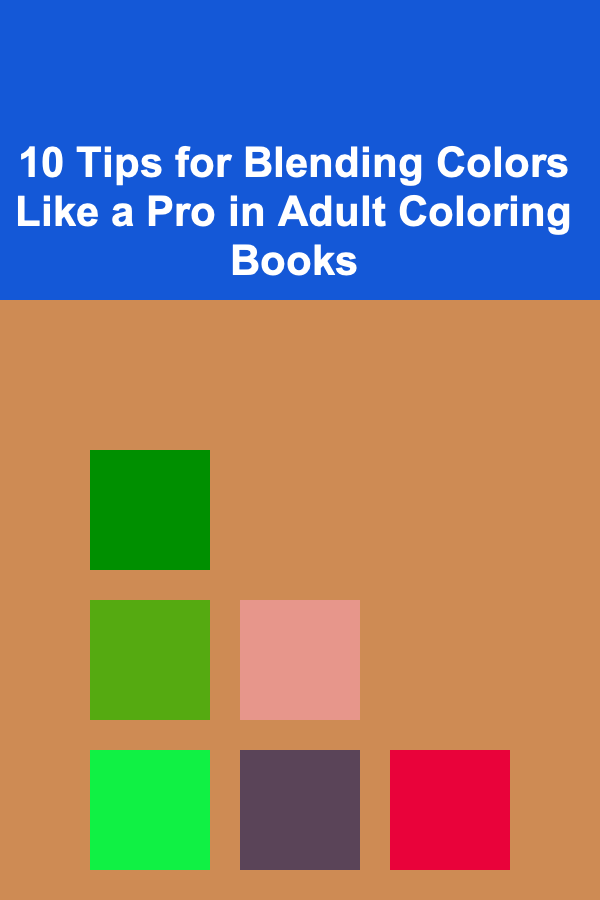
10 Tips for Blending Colors Like a Pro in Adult Coloring Books
ebook include PDF & Audio bundle (Micro Guide)
$12.99$5.99
Limited Time Offer! Order within the next:

Adult coloring books have gained significant popularity over the years as a form of relaxation, self-expression, and even stress relief. Whether you're coloring a detailed mandala, an intricate landscape, or a whimsical animal design, the way you blend colors can make a world of difference in the final result. Blending allows you to create depth, dimension, and smooth transitions between colors, turning a flat, static image into a vibrant, dynamic masterpiece.
However, blending colors effectively can be a bit tricky if you're not familiar with the techniques involved. In this article, we'll go over 10 essential tips for blending colors like a pro in adult coloring books. These tips will help you enhance your coloring skills and make your pages look polished and professional.
Choose the Right Tools for the Job
The first step in mastering color blending is selecting the appropriate tools. Different coloring tools have different blending capabilities, and choosing the right ones can make a huge difference in the quality of your work.
Pencils
Colored pencils are one of the most popular tools for blending in adult coloring books. They are versatile, come in a wide range of colors, and can be used with various blending techniques. When selecting colored pencils, consider using high-quality brands that are known for their smooth application and rich pigmentation, such as Prismacolor, Faber-Castell, or Caran d'Ache.
Markers
Markers are another great option for blending colors, especially if you're looking for vibrant, bold colors. Alcohol-based markers are particularly effective for blending because they are more fluid and dry more evenly, allowing you to create smooth gradients.
Gel Pens
Gel pens can be used for fine details and adding highlights to your coloring projects. While they may not be ideal for large areas, they are excellent for adding accents and layering over colored pencil or marker work.
Blending Tools
Some specialized tools can help you achieve smoother blends, including:
- Blending stumps (for colored pencils)
- Colorless blenders (pencil-like tools that can help you soften lines and smooth out colors)
- Tissue or cotton swabs (for markers and other media)
- Blending brushes (for watercolor or marker-based blending)
Layer Your Colors for Depth
Layering is one of the most effective ways to achieve beautiful, blended colors. Instead of applying one solid color, try building up layers gradually. This technique creates a smoother transition between colors and allows for more control over the final result.
How to Layer Colors:
- Start by laying down a light base coat of your first color.
- Gradually add layers of additional colors, blending each layer as you go.
- Use a light hand to prevent the colors from becoming too dark or muddy.
- Focus on creating smooth transitions from one color to the next.
The key here is to use light pressure and gradually build up the color layers. This allows the pigments to mix together more naturally and prevents you from overworking the paper.
Use a Colorless Blender for Smooth Transitions
A colorless blender is a pencil-like tool designed to smooth out the pigment and blend colors together. It's often used with colored pencils but can also be effective with markers. When you use a colorless blender, the pigment is pushed around the paper, which helps fill in the gaps between colors and creates a smooth, seamless transition.
To use a colorless blender:
- After applying your base colors, go over the entire area with the colorless blender in small circular motions.
- The blender will blend the colors together and soften any harsh lines.
While this method is effective, it's important to remember that it works best when you've already applied enough color to the area. Don't expect the colorless blender to add significant color; it's mainly for smoothing and blending.
Use a Light Hand When Blending
One of the most common mistakes beginners make when blending colors is pressing too hard with their pencils or markers. Applying too much pressure can result in harsh lines and uneven blending. To avoid this, always start with a light hand and gradually build up the color.
Why It Works:
- A light touch allows the paper's texture to show through, which gives your blending a more natural, soft look.
- If you start light, you can always go darker if needed, but it's much harder to correct an overworked area.
A light hand is especially important when using colored pencils, as it prevents wax buildup on the paper, allowing for better color layering and blending.
Experiment with Color Combinations
Effective blending often depends on choosing the right colors to mix together. While complementary colors (colors opposite each other on the color wheel) tend to work well together, experimenting with various combinations can help you discover unique blends that work for your specific project.
Some tips for color combinations:
- Analogous Colors: These are colors next to each other on the color wheel (e.g., blue, blue-green, and green). They blend beautifully and create harmonious, soothing effects.
- Complementary Colors: Colors that are opposite on the color wheel, like red and green, or blue and orange, create contrast and vibrancy when used together.
- Triadic Colors: Colors that are evenly spaced around the color wheel (like red, blue, and yellow) create a balanced, colorful composition.
By experimenting with different color schemes, you can achieve various moods and effects in your artwork.
Blend Dark to Light, Not the Other Way Around
When blending colors, it's typically easier to start with darker colors and blend them into lighter ones. Dark colors tend to saturate the paper more and create a more intense base, while lighter colors are easier to layer on top and soften.
How to Blend:
- Apply the darkest color to the areas where you want the most depth or shadow.
- Gradually blend the darker color into the lighter colors, using light pressure.
- Continue layering lighter colors over the darker ones, using a circular or back-and-forth motion to achieve a seamless transition.
This method helps you control the final outcome and ensures that the darker colors don't overpower the lighter ones.
Create a Gradient Effect
A gradient effect is when you transition from one color to another smoothly, creating a gradual shift. This technique is commonly used in backgrounds, skies, or any area where a smooth transition is desired.
How to Create a Gradient:
- Choose two or more colors that you want to blend.
- Apply the first color to the area you want to start with, then apply the second color where you want the transition to occur.
- Use a blending stump, cotton swab, or colorless blender to gently merge the colors together.
- Gradually fade out the first color while bringing in the second.
Gradients can be achieved with pencils, markers, or a combination of both, and they are especially striking when used in larger areas or backgrounds.
Use Watercolor Techniques with Colored Pencils
If you want to get more creative with your blending, consider using watercolor techniques with your colored pencils. Many colored pencil sets can be used wet, allowing you to blend them like watercolors.
How to Use Watercolor Techniques:
- Apply the colored pencils to your paper as usual.
- Use a damp paintbrush to lightly wet the pencil marks, then blend them out.
- The water will help the pigment spread, creating a smooth gradient effect.
This technique is particularly useful for larger areas or for creating softer transitions between colors. It's also a great way to add a more ethereal or fluid effect to your coloring.
Keep Your Work Area Clean
When you're blending colors, especially with colored pencils or markers, it's important to keep your work area clean to avoid smudges and unwanted marks. Use a clean eraser to remove any stray pencil marks or smudges, and keep your pencils sharp for clean lines.
Some Tips:
- Use a piece of scrap paper or a clean cloth to wipe off excess pigment from your blending tools.
- Avoid using too much pressure on your pencils to reduce smudging.
- Keep your hands clean to avoid transferring oil or dirt onto your paper.
A clean workspace allows you to focus on blending the colors without worrying about unwanted marks.
Practice Patience and Experimentation
Mastering the art of blending colors takes time and practice. Don't be discouraged if your first attempts don't turn out exactly as you imagined. The more you experiment with different techniques, colors, and tools, the more proficient you'll become at blending.
Ways to Improve:
- Try blending different combinations of colors to see what works best.
- Experiment with different blending tools, such as blending stumps, markers, or even your fingers.
- Take your time. Rushed work often results in uneven blending.
Patience is key to developing your skills and producing beautiful, polished coloring pages.
Conclusion
Blending colors like a pro in adult coloring books is an art form that requires practice, patience, and the right techniques. By selecting the right tools, layering colors, using colorless blenders, experimenting with different combinations, and practicing various techniques, you can enhance your coloring skills and create stunning artwork. Whether you're using colored pencils, markers, or a combination of both, blending is a crucial technique for achieving professional-quality results. With these 10 tips, you'll be on your way to mastering the art of color blending in no time.
Reading More From Our Other Websites
- [Home Renovating 101] How to Keep Your Home Safe During a Renovation Project
- [Organization Tip 101] How to Keep Your Bathroom Countertops Clutter-Free
- [Home Renovating 101] How to DIY Your Home Renovation Projects Like a Pro
- [Personal Care Tips 101] How to Choose the Right Face Mask for Your Skin Type
- [Home Pet Care 101] How to Make Your Pet's Playtime Fun and Safe
- [Home Pet Care 101] How to Create a Pet Exercise Routine in Your Home
- [Home Holiday Decoration 101] How to Decorate Your Home for the Holidays with Minimalism
- [Tie-Dyeing Tip 101] Advanced Tie-Dye Techniques: Gradient, Shibori, and 3-D Effects Explained
- [Organization Tip 101] Step-by-Step Guide to Building Your Own Raised Garden Bed
- [Organization Tip 101] How to Create a Family Snack Station in Your Pantry

How to Balance Personal Taste and Market Trends in Collecting
Read More
How to Maximize Space in a Small Laundry Room
Read More
How to Sell Used Appliances on OfferUp: An Actionable Guide
Read More
Using Deep Learning to Make Money in Financial Markets
Read More
10 Tips for Securing an Aerospace Engineering Internship
Read More
10 Essential Skills for Research Assistants in STEM Fields
Read MoreOther Products

How to Balance Personal Taste and Market Trends in Collecting
Read More
How to Maximize Space in a Small Laundry Room
Read More
How to Sell Used Appliances on OfferUp: An Actionable Guide
Read More
Using Deep Learning to Make Money in Financial Markets
Read More
10 Tips for Securing an Aerospace Engineering Internship
Read More